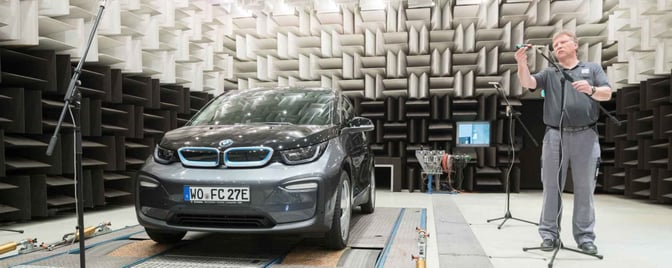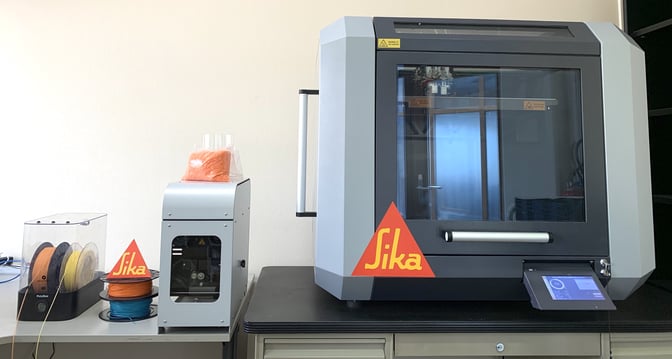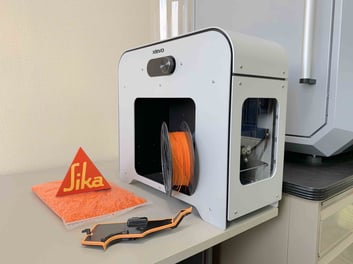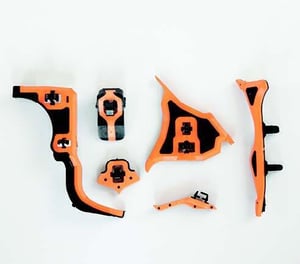Share this
3D Printing Cutting-Edge Acoustic Parts at Sika Automotive
by 3devo on Jun 30, 2020 5:22:00 PM

Behind every state-of-the-art automobile are chassis components engineered to increase performance, acoustic comfort, energy efficiency, and customizability. Sika Automotive specializes in designing and developing these components for vehicle body-in-white. The Composer 350 Filament Maker has recently joined Sika’s pre-series production set up – a move that has put the company on the fast track to futuristic acoustic parts development.
Sika Automotive enjoys the position of a global leader in automotive bonding, sealing, damping and reinforcement solutions. The company collaborates with some of the best-known OEMs in Europe to produce chassis components that are strong, lightweight, and tailored to each vehicle’s design. Among these are a range of innovative cavity sealers that make use of Sika’s proprietary formulation, SikaBaffle®. This highly expandable thermoplastic allows acoustic inserts to be produced using minimal material. But there’s a catch – its low melting point makes SikaBaffle® tricky to process.

The 3devo Composer Filament Maker, shown here along with the German RepRap 3D printer, has been instrumental in allowing Sika Automotive to develop innovative and high-quality acoustic parts in-house.
A quest to innovate, in-house:
Sika’s complex expandable cavity sealers go through a meticulous design and prototyping process before being approved for production. It’s common for a typical SikaBaffle® component to undergo 5-10 design iterations in order to ensure perfect acoustic sealing using the least possible quantity of material.
Up until a few years ago, Sika used injection molding for its prototyping needs. This naturally resulted in a time-consuming and resource-intensive process. Every design modification required new molds and tooling changes, leading to long waits and interruptions in pre-production schedules. The prototype’s performance would often need to be tested via on-screen calculations in order to reduce delays and material wastage. Soon enough, Sika felt the need to bring prototyping and production in-house. They looked at 3D printing as a potential replacement for injection molding – it would offer them the freedom and control they needed, while also shortening lead times for their designs.
Sika’s primary challenge was to assemble an in-house 3D printing setup that could successfully process SikaBaffle® while remaining cost-effective. As a highly expandable material, SikaBaffle® had already proven perfect for developing complex cavity sealers. Further, it had been tested and was available in pellet form. The catch was that its low melting point of 90°C made it incompatible with most filament extruders.


The 3devo Composer Filament Maker (left) can successfully extrude heat-reactive, low-melt polymers like SikaBaffle®. This made the machine a viable option for setting up an in-house production facility for Sika’s complex cavity sealers (right).
Streamlining development efforts with an efficient and cost-effective filament extruder
In July 2018, Sika Automotive approached 3devo to explore the possibility of extruding SikaBaffle® filament using one of our machines. Our Composer 350, which can process medium melt flow index polymers, successfully extruded SikaBaffle® filament without affecting its chemical composition. In parallel, our presence in Europe meant that we could offer Sika on-demand support with their filament making needs. The company added a Composer 350 to their production facility in December 2018, together with the German RepRap 3D printer that had produced good results with SikaBaffle® parts.
With the help of the Composer 350, Sika Automotive has significantly upgraded their prototyping and production workflow. To begin with, the filament maker has enabled them to take complete control over acoustic parts design and development. The ability to 3D print their designs in-house instead of relying on third-party injection molding or water jet cutting facilities, has dramatically reduced lead times. Cavity sealers that once took 4-8 weeks to develop, are now produced within 2-5 days’ time.
In-house 3D printing has also enabled Sika to test prototypes physically rather than on a screen. Many SikaBaffle® components now require fewer engineering change iterations, further optimizing and streamlining pre-series production. Last but not the least, our intuitive and user-friendly machine ensures an efficient workflow, and enables Sika to dedicate time and resources towards making new advancements in automotive design.
Want to read the entire Sika case study? Check it out here!
Share this
- November 2025 (1)
- October 2025 (1)
- March 2025 (1)
- January 2025 (1)
- December 2024 (2)
- November 2024 (2)
- October 2024 (4)
- September 2024 (2)
- August 2024 (3)
- July 2024 (6)
- June 2024 (3)
- May 2024 (2)
- April 2024 (1)
- March 2024 (1)
- January 2024 (1)
- November 2023 (2)
- October 2023 (5)
- September 2023 (2)
- August 2023 (1)
- July 2023 (1)
- May 2023 (1)
- December 2022 (2)
- June 2022 (1)
- May 2022 (2)
- April 2022 (2)
- March 2022 (6)
- February 2022 (2)
- January 2022 (3)
- December 2021 (3)
- November 2021 (3)
- October 2021 (2)
- September 2021 (3)
- August 2021 (3)
- July 2021 (2)
- June 2021 (1)
- March 2021 (1)
- October 2020 (1)
- June 2020 (1)
- May 2020 (1)
- April 2020 (4)
- November 2019 (1)
- July 2019 (2)
- June 2019 (1)
- May 2019 (1)
- March 2019 (1)
- November 2018 (1)
- September 2018 (1)
- January 2018 (1)
- October 2017 (1)
- September 2017 (1)
- July 2017 (1)
- June 2017 (1)
- May 2017 (1)
- January 2017 (1)
- December 2016 (3)
- November 2016 (2)
- October 2016 (1)
- May 2016 (2)
- August 2015 (2)
- July 2015 (1)